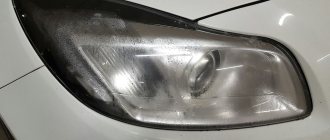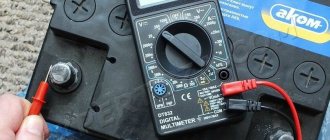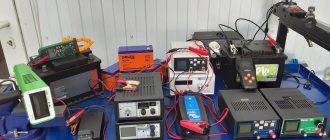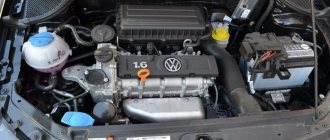Before replacing a dead battery, perform a few simple tests.
Reasons why your battery won't charge
When a car battery dies shortly after turning off the engine, it is usually due to one of three reasons:
- Your battery has reached the end of its service life (often 4 or 5 years).
- Parasitic drain drains battery power.
- A problem in the electrical system affects the battery charge.
Many battery problems can be diagnosed at home using a visual inspection, a digital multimeter, or an inexpensive hydrometer that can be purchased at most auto parts stores.
This guide shows you how to use a few simple tests to find the cause of the battery failure and find out why your car's battery is dying. These tests are easy to administer for the average car owner. However, you will be advised when the time comes to take the battery to a store if necessary to confirm the diagnosis.
So, let's find out why your car battery is not holding a charge.
The battery is draining why it won't hold a charge
- Inspect the battery.
- Check the battery terminals.
- Clean the battery terminals.
- Perform a battery voltage test.
- Do a quick check of the charging system.
- Check the battery for leaks (and repair any leaks).
- Do a battery drain test.
- Perform a hydrometer test.
- Do an alternator test.
- Check the other "bank" battery compartments.
Instructions and tips for each of these tests are provided below.
How do you know when your battery is close to being completely discharged?
From the previous parameters, you understood why the car battery drains quickly. It remains to say a few words about how to understand that a complete discharge of the battery is approaching.
In most cases, battery discharge occurs unexpectedly and is very unpleasant. But you can feel it coming by the slow cranking of the crankshaft. A charged battery supplies normal current to the generator, but a discharged battery does not have enough charge for this.
As a result, the starter turns the shaft more slowly than usual. Even if you managed to start the engine the day before with this problem, the next day the battery will completely run out. Therefore, when you arrive from work, immediately put it on charge. Otherwise, in the morning you will be looking for how to start the car if the battery is dead.
You can also play ahead of this situation before the cold weather. If you have been using the battery for 3-4 years and everything is fine in the summer, then with the onset of cold weather there will definitely be problems. To prevent this from happening, watch the forecast and recharge the battery from the mains charger before the arrival of negative temperatures. Additionally, you can read the article about whether it is possible to charge the battery in a car without removing the terminals.
Check the battery
In many cases, problems with a battery that won't hold a charge can be due to poor battery maintenance. For example, you may forget to check the battery's electrolyte level, check the terminals for corrosion or looseness, or make sure the battery is held in place to prevent physical damage.
Start diagnosing a low battery with a visual inspection. A simple inspection can help you quickly identify problems that could lead to battery problems.
For a better test, it is recommended to disconnect the battery and check it. However, before disconnecting the terminals from the battery, save all your settings on the car's on-board computer.
If you don't want to buy a memory stick now, you can use a 9V battery instead. Connect the 9V battery to the car battery terminals before disconnecting the cables.
Remove the car battery and inspect it:
- Check the battery case for cracks and damage
- check the electrolyte level if your battery has removable caps
- and check the body for bulges
If the battery is damaged, replace it. Also, make sure all mounting hardware is in place and clean the battery compartment.
Why save your car's memory?
You can use the memory save function (or 9V battery) to save your car's memory. First, it avoids losing settings on devices such as stereo systems.
Additionally, on modern vehicles, the vehicle's computer memory receives information while the engine is running from a variety of different system sensors, including ignition timing and injector pulse width, to improve drivability. If your computer loses this information, the relearning process can take hundreds of miles of engine operation.
Corroded, loose or damaged terminals can prevent the alternator from charging the battery.
How long to charge a dead car battery?
The energy spent on starting the car, servicing the alarm system and other on-board systems is replenished by the generator. The voltage in the relay network is regulated by a regulator, which is designed for 13.9 - 14.3 V. The battery is not fully charged and periodically requires recharging. After being idle, the remaining battery charge may not be enough to start the engine. How to determine how long to charge a dead battery?
To charge a dead car battery, you will need to determine the degree of discharge of the battery by the voltage in the open circuit. In a serviced or hybrid battery, the residual charge can be determined by the actual density of the electrolyte.
The charging time is set by dividing the charging capacity by the charging current, which should be less than 10% of the charging capacity. The efficiency of the electrochemical reaction is assumed to be 50%. This means that the calculated time should be doubled.
Before charging, a dead car battery should be prepared for recharging - cleaned of dirt and acid deposits on the terminals. The plugs of low-maintenance batteries need to be unscrewed, the density and level of electrolyte in the banks must be checked.
To quickly charge a dead battery, you can use a mode with a current of 8 A for 3 hours and another hour with a current of 6 A. How long should you charge the battery so as not to harm it? It is optimal to use a current of 2-3 A, eliminate overheating, overcharging, and create the best conditions for long-term operation of the charger.
You can charge a dead car battery locally, but you need to assemble the circuit correctly. You should disconnect the negative wire and break the line so that the increased voltage does not harm the on-board network.
Work related to charging batteries is considered dangerous. An acid battery is filled with a caustic concentrated acid solution. Properly prepare and charge the battery while wearing rubber gloves in a ventilated area. Gases released from cans are explosive. There is no need to bring a lighter or open flame to the hole.
Check the battery terminals
Testing your battery terminals helps you check if your wire terminals are making good contact with your battery terminals. Basically, the test measures the voltage drop between the battery terminal and the wire terminal.
A high voltage drop indicates that the charging system is having difficulty supplying sufficient charging voltage to the battery. This, in turn, means that the battery has difficulty supplying power to the starting and fuel injection systems and other circuits during startup.
- First disconnect the fuel system by removing the fuel pump fuse. To find the fuse, locate the fuse box (inside the cab) or power supply (in the engine compartment). Removing the fuse will prevent the vehicle from starting during the test. On vehicle models with a distributor, you can prevent the engine from starting by disconnecting the ignition coil wire from the distributor. You can then use a jumper wire to connect the cable to a good engine ground (any unpainted metal part on the engine, such as a bolt or bracket, will do).
- Set the digital voltmeter to a low value on the direct current (DC) volt scale.
- Connect the negative lead of the voltmeter to the positive battery cable terminal (terminal o).
- Connect the positive (red) lead of the voltmeter to the positive terminal of the battery.
- Have a helper set the parking brake, put the transmission (automatic) or neutral (manual), and run the engine for a few seconds, just enough to get a good voltage reading, but not more than 30 seconds. If you need to start the engine again, let the starter run for a minute or more before starting the engine again.
- If your voltmeter reads a voltage drop of more than 0.1V, the battery connections are loose or dirty. Inspect connections for corrosion, looseness, or damage.
- If the terminals are corroded or dirty, see the Cleaning the Battery Terminals section below.
- Repeat steps 3 through 6 on the other battery terminal, but connect the negative voltmeter lead to the negative battery terminal, the one with the "-" sign, and the positive voltmeter lead to the terminal.
Can the alarm drain the battery?
A standard alarm consumes 0.08 amp/hour. Complex alarms with remote notification spend 30% more. This is not much; a 60 Amp/hour battery will discharge after about a month of inactivity.
The alarm works like this: when armed, it goes into “sleep” mode. Current consumption is minimal. When a contact in the sensor circuit is closed, the unit is triggered, sending a signal to the headlights and siren, as well as an alert to the key fob. Modern alarms are able to respond to loud sounds, vibrations and even excessive proximity to the car. Such systems consume more current because they use the radar principle or photocells.
Reasons why alarms consume more current.
- Presence of a radio warning module. It requires more energy to operate than the alarm itself.
- Defective signaling circuits.
- Incorrectly installed or overly sensitive sensors. The alarm goes off; if the siren is broken, this leads to an increased discharge.
- Immobilizer activation. In this case, the battery will work, but the ignition will not turn on.
- A faulty autostart was trying to start the engine. The starter quickly drains the battery.
- The autonomous type alarm system has its own battery. If it wears out, the relay tries to charge it and “pulls” energy from the main one. Therefore, it is better to install a dependent alarm or check the battery of the main one.
Attention! Install and repair alarms in a specialized workshop from an experienced auto electrician. Incorrect connections or exposed wires may cause fire or serious damage.
It is quite difficult to check the serviceability of the alarm, since the discharge can be short in time and impossible to track. The test is simple:
- The alarm is turned off and the car is operated without it. If the battery does not discharge, it is worth diagnosing or installing a new unit.
- The hood rises, the sensor end is clamped. We measure the alarm current consumption. We provoke accidents - we knock on the fenders, we shake the car. The alarm consumes more current during activation, but after a set time it should turn off and not consume excess energy. If the alarm does not turn off, it can easily “drink” an entire battery overnight.
How to clean battery terminals
Corroded battery terminals will not allow the starting system to function properly or the charging system to charge the battery. Cleaning your battery terminals is a simple procedure.
- Connect a memory drive or 9V battery to the cables before disconnecting them to preserve the computer's memory and other important settings.
- Disconnect the battery cables.
- Prepare a mixture of 8 ounces warm water and a tablespoon of baking soda in a small container.
- Use a small, soft brush to apply the solution to the battery terminals and wire terminals.
- Remove corrosion and dirt from the battery terminals using a battery terminal cleaning tool. This is a special brush for cleaning battery terminals and contacts. Use a small wire brush to clean the side terminals.
- Wipe all contacts on the battery and terminals with a cleaning solution.
- After reconnecting the terminals to the battery posts, apply a thin layer of Vaseline or white grease to the terminals and posts to prevent corrosion of the terminals.
Use a digital multimeter to test your battery and other systems that affect battery charge.
Battery problems
Leakage current
For cars equipped with security systems and other consumers of electricity whose memory is not non-volatile (for example, audio systems), spontaneous leakage of current is a normal phenomenon. In addition, minor losses may occur due to the formation of current-carrying “bridges” formed from water and dirt between the terminals of the connecting blocks.
The question is how big the leakage is. For domestic cars, its maximum indicator should not exceed 0.075 - 0.08 A, for foreign cars - two times lower. For clarity: in the circuit of a switched on brake light or turn signal lamp, the power of which is 21 W, a current of ≈ 1.75 A flows. That is, if the leak is within the normal range, it is not capable of “draining” the battery even after several days of inactivity.
High leakage current
The leakage current should be measured with a milliammeter connected between the “positive” terminal, disconnected from the battery, and the corresponding (positive) terminal.
To prevent excessive current from flowing through the device when the electric locks are activated, temporarily bypass it with a piece of wire!
Short between plates
Short circuits between positive and negative plates occur for the following reasons:
- Damage to separators
- Formation of bridges (dendrites) from contaminants
- Sludge accumulation at the bottom of the battery
Either several batteries or just one can short out - the battery is in any case unsuitable for use. You can detect the fact of a short circuit inside the battery using a load plug - when its additional resistance is connected, the closed banks will “boil”, and the voltage at the battery terminals drops below 9 V.
A shorted battery cannot be restored.
Sulfation of plates
During the flow of discharge current through the circuit, salts formed as a result of the reaction of lead and sulfuric acid - sulfates - form a coating on the plates. Partial sulfation is a completely natural phenomenon. When charging a battery, reverse reactions occur, as a result of which sulfate particles disintegrate and both the platinum material and its coating and the density of the electrolyte are restored.
Sulfation of plates
During a deep discharge, sulfates form such a dense crust that it prevents the interaction of ions with the substance of the plates. As a result, both charging the battery and delivering electricity to it becomes impossible.
Sometimes, while not the entire surface of the plates is covered with sulfate crust, it is possible to revive the battery with several charge/discharge cycles. Such training cycles can also be carried out for preventive purposes, without waiting for the battery to “unreasonably” run out in one day.
There is no way to clean the plates mechanically, so batteries that have undergone deep discharge in most cases go to waste. To prevent this from happening, you should not “squeeze” the battery when trying to start it by rotating the crankshaft with the starter for a long time - once the battery is set to “zero,” it simply “will not accept” charging.
Low electrolyte level
The electrolyte level should be such that there is a distance of 15 - 20 mm between its surface and the upper edges of the plates.
A low level indicates that the water contained in the electrolyte has partially boiled away. As a result, the concentration of sulfuric acid in this case increases, which causes active corrosion of the plates.
But adding distilled water without checking the density of the electrolyte is allowed only in hot weather - otherwise, if it is too diluted, it can destroy the battery case when frost sets in. Insufficient density can be restored by adding a correction solution with a density of 1.4 g/cm3, sold in stores.
Do not allow dirt to enter through the holes in the battery case when measuring density and adding electrolyte - it will cause a discharge current between the plates!
Shedding of plates
The coating of the plates is also involved in chemical reactions during the charge/discharge processes, and its shedding reduces the energy output of the battery. In addition, its crumbled particles cause current leakage inside the power source.
Plate failure
As a result, both the capacity and the starting current of the battery drop. The main reasons for plate shedding:
- Excessive charging voltage and current. The voltage should not exceed 14.4 V, and the charging current should be 10% of the capacity. That is, a battery with a capacity of 75 A/h must be charged with a current of 7.5 A.
- Vibration and shock perceived by the battery case due to poor fastening of it to the car.
The plates cannot be replaced - the body of a modern battery is non-separable.
Terminal oxidation
Terminals made of iron alloys suffer the most from oxidation - they are the most susceptible to corrosion. Over time, the contacts of the terminals with the battery terminals and with the wires are broken, which prevents both the full charging of the battery and the supply of it to consumers. To protect the terminals from oxidation, a thin layer of grease is applied to their surface.
Lead terminals do not oxidize, but over time their “grip” weakens - the ductile metal is easily deformed. Such terminals can be restored by increasing the gaps in their “locks” with a file.
Low starting current
When purchasing a battery, you need to pay attention not only to its capacity, expressed in ampere-hours, but also to the amount of starting current indicated on the case sticker along with other data. An incorrectly selected battery, even if it is not discharged, will not allow the starter to develop the required power when cranking the engine.
Particular attention in this regard must be paid when choosing a battery for a car with a diesel engine - higher compression in diesel cylinders provides greater resistance to cranking.
In cold regions, you need to install a battery with a high starting current
In general, purchase a new battery in accordance with the recommendations of the car manufacturer. A battery that has larger capacity and discharge current values than necessary will not be charged 100% during operation - the current power generated by the generator will simply not allow it. Constant “undercharging” will inevitably shorten the life of the power source.
Perform a battery voltage test
Maintenance free batteries (no removable caps) come with a charge indicator (check indicator eye) that tells you whether your battery is charged (green eye), needs a charge (no color visible), or the battery needs replacing (yellow eye).
Checking battery voltage is especially useful for maintenance-free batteries because it allows you to quickly determine the state of charge and condition of the battery. On regular batteries (those with removable caps), you can do a test using a hydrometer, which can also tell you if your battery is working (see the Hydrometer Test section below).
Using a DMM to test the battery:
- First, turn on the high beams for ten seconds. Then turn them off and wait two minutes (this will remove any excess charge above 12.6V, commonly called surface charge).
- Disconnect the negative (black) cable from the battery.
- Set your digital multimeter to 20 V DC (DCV).
- Connect the device to the battery terminals.
If you get a reading between 12.4 and 12.6 , your battery is well charged. If you suspected a battery problem because you had trouble starting the engine, or you had problems with another electrical circuit, or the alternator warning light on your dash is on (problems with charging the system), your problem is not with the battery.
If the voltage value is below 12.4 V , the battery is not sufficiently charged. You may have a problem with the battery itself (see State of Charge table below). Charge the battery and repeat the test. If you get the same readings (and problems) after charging the battery, you can take the battery to the store to have the battery charge checked. This is one of the best ways to confirm the battery status. However, the following tests may shed more light on the condition of your battery before you take it to the store. Continue with the next tests.
| voltage | Interest fee |
| 12.6V or higher | 100 |
| 12.4V | 75 |
| 12.2V | 50 |
| 12V | 25 |
What voltage tells you the state of charge of your battery
Problems with the alternator can drain the battery.
Services
It happens that there is no time to charge the battery. Sometimes this cannot be done because you do not have your own charger. It also happens that some car enthusiasts do not understand the structure of their car. The answer for all these options to the question of how to fully charge a car battery is to contact a special service that provides similar services. A one-time charge will cost you about 150 rubles.
But it’s worth remembering that you shouldn’t limit yourself to charging alone. Sometimes you need a little more manipulation to extend the life of your battery. Services include measuring the density of the electrolyte (if necessary, the density will be increased or decreased). Such services cost about 100 rubles. Prices are relevant for most regions of Russia.
Car battery drains overnight - Do a quick check of the charging system
Another quick test you should do before proceeding is to perform a quick charging system check. Make sure both the negative and positive battery cables are properly connected and clean.
- Set the voltmeter to 20 VDC.
- Have a helper start the engine and run it at 2000 rpm.
- Connect the meter leads to the battery terminals.
- Your voltmeter should read between 13.5 and 14.5.
Please note that you should get a steady reading. If the readings change, check the charging system wiring for loose connections; Another possibility is a faulty alternator or voltage regulator.
If your readings are lower or higher than the specifications, you may have a bad voltage regulator. Consult your vehicle's repair manual; he can tell you how to do some quick checks on the generator.
No charge from generator
If your car's recently purchased battery runs out quickly, or the discharge occurs gradually and systematically over the course of a week, then you should think about the serviceability of the generator. In this case, the first action should be to diagnose its condition.
This is interesting: What is the capacity of a car battery?
How to determine that the charge from the generator is sufficient? To do this, you need to check its operation using a multimeter. This device needs to measure the voltage at the battery terminals with the headlights, heated windows, music and engine on. Its value should normally be in the range of 13-14.4 volts. If the result obtained differs to a lesser extent, then the problem is precisely the insufficient supply of charge to the battery from the generator.
The reasons for this generator problem may be as follows:
- voltage regulator failure;
- weakening of the belt tension or its breakage;
- diode bridge fault.
If the battery is constantly discharged due to problems in the generator or insufficient charge from it, you need to contact specialists at a car service center to diagnose and repair the breakdown.
The car battery discharges quickly - Check the battery for current leakage
If your battery is in good physical shape and has strong, clean, and secure connections, the battery may be dead.
This can happen when you allow the battery to accumulate a layer of dirt or acid, especially around the top. This test is simple and quick. And all you need is your voltmeter.
- Set the voltmeter low on the DC voltage scale.
- Connect the black test lead to the negative terminal of the battery.
- Touch the top of the battery in various places with the red meter lead.
- If your meter registers even a small amount of voltage at any point, your battery is draining. You need to clean your battery.
Cleaning the battery to eliminate leaks
- In a small container, combine about 8 ounces of warm water and a tablespoon of baking soda.
- Apply the mixture to the top of the battery with a soft brush and wipe the top with a shop rag. If the battery has removable caps, be careful not to let the cleaning solution get into the battery or it may ruin it.
- Make sure the top and the rest of the case are perfectly clean.
- Repeat the leak test to ensure that the discharge has stopped.
If you leave the headlights or other electrical device on after turning off the engine, the battery will discharge.
When deep discharge occurs
Normal discharge of a smartphone or tablet is considered safe for modern lithium-ion (Li-Ion) or lithium-polymer (Li-Poly) batteries. The main thing is to charge the device as soon as possible. If the owner forgets to do this and leaves the gadget discharged to zero for several days, an unpleasant deep discharge effect may occur.
Typically, when a device is completely discharged, it always leaves a small amount of energy left to maintain functionality. For example, a smartphone will automatically turn off if its battery is 96-97% empty. Several repeated starts without recharging can reduce the emergency reserve to zero.
The deep discharge effect occurs when the device automatically turns off at the battery indication level of 0%-1% and then lies in this state for several days without charging. As a result, the controller inside the battery turns off the electronic circuitry of the discharged battery.
To extend battery life, keep the charge level between 20% and 80%. A constant partial charge approximately doubles the battery life. Regular discharge to zero and charging to 100% will shorten the service life.
According to the developers, such a sleeping battery should start working immediately after connecting the charger. In practice, the battery often does not want to wake up, the gadget’s screen may show a completely discharged icon, and the smartphone or tablet refuses to charge.
The battery in your car is dead, do a battery discharge test.
Power leaks are not the only reasons why car batteries leak electricity. Another common source of waste is parasitic loads. Parasitic loads come from electrical or electronic devices that remain active after you turn off the engine and remove the key from the ignition.
Almost all modern cars consume a small amount of power after the engine is turned off, for example for the radio, instrument panel, alarm clock and computer modules. But these small, normal parasitic loads can turn into power drains if you leave your car parked for days without running the engine. Old batteries are more susceptible to this type of discharge than new ones.
In addition, abnormal parasitic loads may suddenly appear. This is due to a short circuit or worn devices that cause the circuit to remain energized when it shouldn't or is faulty, or to a module or switch that causes the load to remain on after the ignition is turned off.
If you are unaware of the problem, the parasitic load can drain your battery overnight.
You can find many abnormal parasitic loads using a simple method. During this test, make sure the doors and trunk are closed so that the light or dome light does not come on. Also, loosen the light under the hood to turn it off if necessary.
If you find a parasitic load, you will need to access the fuse box or power supply. If the fuse boxes are located inside the cab, keep the front door or doors open, but use a clamp or similar device to keep the door switches in the off position.
For this test, you can use a memory stick or connect a 9V battery to the battery terminal (see the "Saving your computer's memory" text box above).
- Set up your digital multimeter to read DC amps.
- Remove the key from the ignition and keep all accessories turned off.
- Disconnect the negative battery cable (the one next to the "-" sign).
- Connect the negative (black) test lead to the negative terminal of the battery.
- Connect the positive (red) test lead to the terminal of the cable you just disconnected. NOTE. On some late model vehicles, you may need to wait about 30 minutes after turning off the engine and connecting the ammeter to allow all computer modules to go into sleep mode. If necessary, consult your vehicle's owner's manual.
- Read the display on your voltmeter. On average, a normal reading should be between 0.01 and 0.5 A (this depends on the specific model, the number of electronic modules and power devices that remain on after the engine is turned off). Your vehicle's owner's manual can give you the normal parasitic load for your vehicle model.
- If you get readings above 0.5 A or more, you most likely have a parasitic load. This means that the energized circuit is draining the battery.
- If you suspect an abnormal parasite load, start pulling fuses. Pull one fuse at a time while watching the meter. When the high value drops, you have found a faulty circuit. You need to check if there is a short circuit in the circuit or a faulty device causing the leak (bulb, relay, module, etc.).
- If you can't find the source of the parasitic load by pulling the fuses, there may be a problem with the starter solenoid (selector relay) connections or circuit. Disconnect the wires at the solenoid (if you need to disconnect the battery cable to disconnect the wire at the solenoid, be sure to reconnect the cable); check your meter readings. If the extra load goes away, check the wires that connect to the solenoid and look for shorts, damaged wires, etc.
- Another device that can cause energy consumption is a generator. Disconnect the generator electrical connector. If the voltage reading drops to the normal 0.01 or 0.02 amps, check the alternator.
A moisture meter can show the state of charge and health of your battery. |Source
Why do you need to periodically discharge your car battery?
To understand the meaning of battery discharge, let's remember how it works.
When we turn the key in the ignition, we start a process consisting of the interaction of two battery reagents - lead plates and electrolyte. Closing the electrical circuit initiates the release of electrical energy released during the process of reducing the density of the electrolyte. This process is accompanied by the conversion of some of the lead on the plates into lead sulfate. The reverse process, that is, charging the battery, converts most of the sulfated lead back into pure metal.
As you already noticed, we mentioned the term “most”. This means that some amount of insoluble sulfate remains as such, and this process is commonly called plate sulfation. As the proportion of insoluble residue on the plates increases, the battery capacity begins to decrease. This, so to speak, is the aging of the battery, that is, a completely natural process. The analogy is not direct, but it is successful - the life of the battery, it turns out, can also be extended.
The “correct” lifestyle involves training the battery through cycles of discharging and subsequent charging, during which the battery remembers how to convert lead salts into lead with minimal losses. Such demonstration training must be organized at least once a year, on the eve of the onset of the cold season, and even better, repeat the procedure in the spring.
The event also allows you to assess with great accuracy the condition of the car battery and the degree to which its service life is depleted. You just need to discharge and charge while controlling the time and charge level.
Do a hydrometer test
Like a voltage test, a hydrometer test lets you know the state of charge (and condition) of your battery in a few minutes. This test can also detect a failure. This test is performed on a battery with removable caps.
The test measures the specific gravity of the electrolyte in each cell. It compares the specific gravity (density or weight) of an electrolyte to water. Since electrolyte is heavier than water, you can use a hydrometer test to determine whether your battery is charged, discharged, or destroyed.
You'll perform this test using a hydrometer, an inexpensive tool that can be purchased at most auto parts stores or online. Moisture meters come in one of three main types: ball, needle or float. If possible, take a hydrometer with a thermometer so you can compensate your readings with the ambient temperature. Follow the instructions included with the tool you are using.
- A fully charged battery results in readings between 1.265 and 1.299 for all cells. The lower the value, the lower the charge.
- A discrepancy of 25 to 50 points between any two cell readings may indicate a weak battery.
The hydrometer results are a general indication of the health of your battery. If you need to confirm or conduct further tests, you can ask the store to perform a battery charge test. These tests are the best indicator of battery performance.
The generator diodes (connected to the yellow wires) allow current to flow in one direction.
Your car's battery suddenly runs out: are you sure you're not distracted?
A simple reason for losing all charge literally overnight could be elementary absent-mindedness. For example, when parking the car, the owner forgot to turn off the lights or the music. Therefore, rule No. 1 is to remember/check whether all electrical appliances connected bypassing the ignition switch were de-energized.
We recommend checking it out, especially if there are children in the family who are partial to the car. Sitting in the driver's seat as a child, there is a desire to twist everything that turns, including the buttons that turn on the consumers.
Well, and a cigarette lighter. It works in almost all cars, even when the keys are far from the ignition switch. This means that the navigator, recorder and other non-standard gadgets steal current from the battery when it is idle. Therefore, make it a habit to unplug all cords from the socket when parking your car for a long time.
Thorough vehicle check
Many cars these days are equipped with an on-board computer. Naturally, it also consumes energy during the very period of time when there is no one in the car and it is parked. However, it (the computer) requires very little current - 50 milliamps per hour is enough for it, although there are also on-board computers that consume even less energy. In order not to get lost in guesswork, each motorist can personally open the on-board computer service manual and see in it exactly how many milliamps per hour it consumes. But no matter how it is, this device is not capable of discharging the battery in a car on its own.
The engine will not start: How to find out the cause of the problem
A multimeter will help you find other devices that are responsible for current leakage in the car. It is quite inexpensive, somewhere around 20 US dollars. But before measuring the amount of current consumed by devices, it is necessary to fully charge the battery. Then you need to turn off all devices and close all doors in the car tightly. After all this, you need to open one door in the car on the driver's side. In some car models, when this action is performed, the fuel pump immediately turns on, which immediately injects fuel into the engine so that it starts up faster. This process consumes more than 100 milliamps of current.
Energy-intensive cables connected directly to the cigarette lighter can also consume current. As a rule, these are chargers from a mobile phone, from a tablet, from a GPS navigator, etc. devices Even if they are completely disconnected from such a cable, the plugs in them still continue to consume a small amount of milliamps of current. At the same time, some cars have a stereo amplifier in the trunk itself, which is also recommended to be turned off for a while. It is necessary to pull out the fuses themselves in the machine block.
True, one of the points worth considering here is that some on-board computers and anti-theft systems require entering a special code after a forced shutdown. This is usually indicated in the user manual. But, if it is not there, then the driver will have to contact an official dealer. So, friends, remember, before removing the fuses from the block, which are directly responsible for the operation of these systems, you need to find out the special code in advance, if of course there is one.
But to truly get to the bottom of the root causes of current leakage, you will have to take some measurements with an ammeter on the highest range. It should reach 10 or 20 amperes per hour. However, you should not start the engine or turn on the car's headlights, as they can confuse you due to the fact that they consume a large amount of rated power. If the ammeter does not detect any leaks, then you should reduce this range to 2 amperes or 200 milliamps per hour. There shouldn't be any misfires here anymore. The ammeter will definitely record (“catch”) those devices that “steal” current from the machine. At the same time, friends, you should not rush to final conclusions. For example, the same alarm or automatic brightness control system continues to consume energy for 20 minutes after it is turned off, so be patient and wait.
See also: Is dash cam evidence?
And so, you managed to find out how much current the battery consumes at the very time when the car is parked. Now all you have to do is identify the very devices that cause its leakage. To do this, you need, again, to start pulling out the fuses one by one. Just don’t rush, friends, and remember exactly the nests on which they stick out (are located), so as not to get confused later when returning them to their original place.
Finally, you managed to identify those main devices that “steal” current from the battery. But the verification is not over yet. It is possible and most likely that there are many different reasons for battery discharge. Individually they are completely harmless, but taken together they can completely “kill” the battery.
To identify these minor causes, you will need to create a small electrical circuit and connect additional batteries to the car’s battery. In this case, it is necessary to maintain continuity through the jumpers so that the clamp provides good charging contact. However, this is not for long, then you need to remove this fuse and use the multimeter wires, which are equipped with a terminal jumper with a fuse. You will then need to disconnect all of these devices from the circuit one at a time. Finally, you should check the meter. If the voltage in the circuit drops sharply, then it follows that you have managed to detect the problem that has arisen. This could be anything, but our experience itself suggests that it can be triggered by certain phenomena, which will be discussed below.
Long-term parking
In order not to be unfounded, let's calculate on a calculator what kind of parking can be called long-term with a known leakage current and approximate battery capacity. Let's say the battery is new, and it actually has 60 Ah. Before long-term parking, you fully charged it 100% from a stationary charger. We measured the leakage current with the alarm on. Let's say it's rather big - 150 mA.
We count. With a consumption current of 150 mA, the machine will “pull” 0.15 A*h from the battery in one hour. Per day - 3.6 Ah. How many days will 60 A*h last in such situations? For about half a month. But…
This is only provided that you can really “stuff” 60 A*h into the battery, and you really “stuffed” them there. Only then can you count on such a long stay. However, you should understand that we have calculated the time until the battery is completely discharged. This means that you will no longer be able to start the engine, because there will be no energy for the starter. In addition, the calculated time can be significantly reduced if the car is left standing in the cold.
If the battery is dead and you need to drive: what to do?
Without the right tools and knowledge, you should not try to repair the battery yourself. This will only give a negative result. With such amateur activities, there is a high risk of damaging the wiring, as well as the electronic components of the machine.
Whatever the driver does, it is necessary to remove the keys from inside the car and keep them with him at all times. This is done in order to prevent a situation where the central locking of the car works and it is impossible to get into it because of this. It is advisable to ensure that the car door is always open.
To continue moving you can do:
- trying to light a cigarette with or without wires;
- push start the car;
- start the car using ROM.
Got a marriage
This reason is quite rare, but it should not be completely ruled out. Defective batteries can still be found in the age of advanced technology. As a rule, more experienced car enthusiasts are able to identify defects even before the battery is installed on the car. To do this, just check the product upon purchase using a multimeter and a load fork. Well, if the battery has liquid electrolyte and you have access to it, then you can still look inside and measure the density in all the “banks”.
It is also possible to identify a defective, maintenance-free battery. Using the same load fork. In addition, a competent car owner never installs a new battery in the car without first fully charging it using a stationary charger. And this procedure also allows, if you have experience, to identify a defect and immediately get your money back.
From the author’s personal experience... Among the four batteries purchased (inexpensive, but with well-known names) in small country shops, only one was defective. If not for this case, then the item in question would not have been in the above list of reasons for the rapid discharge of a new battery...











